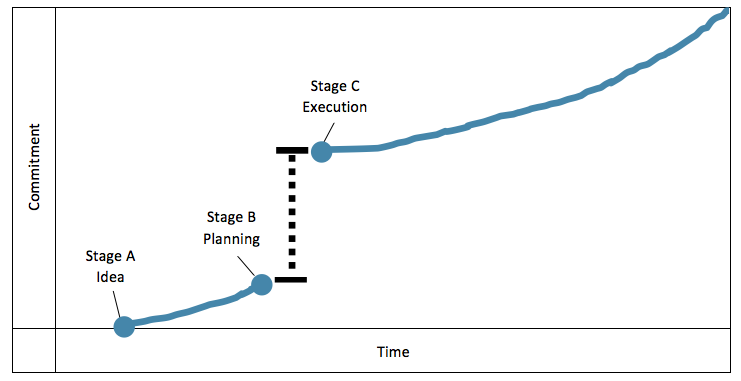The term “side hustle” is a huge misnomer. Why? Because “on the side” means that your new endeavor is going to fit in nicely with everything else going on in your life: work, school, significant other, family, friends, fitness, sleep—ok, we get it. You’re really busy. And that’s the allure of a side hustle. You normally wouldn’t have time for it.
I had this mindset when I started my website. I was recently married, had a job as a financial analyst, was getting my MBA, and had just bought a house. Enter, the side hustle. It was the perfect answer to the age-old question I had been struggling with: how do you manage to do everything, but then also do one more thing?
The side hustle is the life hack seemingly every millennial is talking about. In the beginning, it seemed to work for me. My co-founder and I would tag up for hours to brainstorm. We would think through potential business plans, benchmark the competition and sketch wireframes. When we finally decided to move forward with one of our ideas, we bought a domain name and created a basic website with WordPress. We were at Stage B on the side hustle continuum.
This is the stage I’ve seen so many of my friends get to. You have a good idea, you listen to podcasts like “How I Built This” and “Masters of Scale,” and you use words like “MVP,” “exposure” and “traction.” All joking aside, you have more than just an idea. You’ve made a small amount of progress and gained a small amount of momentum, like we had.
Related: How to Channel Your Skills and Find Your Best Side Hustle
But then you get to the point where you realize that all of that planning was relatively easy. Now you realize that if your side hustle is ever going to become something, you have to start executing your plan. You realize you have to invest a lot more time into it than you currently are, and that there’s a huge difference in commitment between Stage B and Stage C.
Take our blog, for example. We published a few dozen posts on our website, Facebook and Instagram, where we received a few dozen visitors. Our side hustle wasn’t really impeding our everyday lives, but it wasn’t really doing anything particularly exciting, either.
The issue we were dealing with was that nobody knew about us, a problem many wantrepreneurs face. When we started blogging, we naively thought that just by publishing content and linking to it on Facebook, people would share it, and we would go viral.
What we found was that an average of 20 people would see our Facebook posts. Our website didn’t register on the first 10 pages of Google search results. To summarize, our content wasn’t going anywhere. The internet gave us access to so many potential users, but expecting them to come to us was an amateur move. We had to figure out how to get our content in front of them, which is easier said than done.
We didn’t know what to do next, but we knew that we would never succeed with our website if our side hustle was just something we only worked on part-time. We realized we needed a two-month jump on content in order to design marketing campaigns around cornerstone posts. Facebook and Instagram could no longer be afterthoughts, and we had to actively reach out to countless other bloggers and websites.
While I obviously haven’t figured out all of the answers, I believe we can all learn from our fellow entrepreneurs living the struggle. So, for those of you who are thinking about starting a side hustle, here is some advice:
- Quit playin’ yourself: If you’re thinking about starting a side hustle, you’re probably no slouch. Just remember, calling it a side hustle doesn’t take anything off your plate or give you more hours in a day. Your side hustle is just one more thing that you have to allocate your limited time to. And if it is ever going to be what you want it to be, it won’t be just a side hustle. You’re going to have to give up some really important things in your life to make it happen.
- If you have a co-founder, have an uncomfortable conversation with him or her: To make time for my website, I’ve sacrificed time and effort at work, pulling back from a career with clearly defined paths toward raises and promotions to pursue a website that’s a long way from revenue generation. It sucks to feel like you’re sacrificing more or putting in additional work for your side hustle than your co-founder is. I’m not saying he or she also has to sacrifice work, but it’s vital that you and your co-founder are aligned and on the same page about your goals.
- If you have a significant other, have another uncomfortable conversation with him or her: Don’t assume your side hustle won’t impact your relationship. You can imagine the joy my wife expressed when I sprung this side hustle idea on her amidst midterms and home renovations. She wanted me to pursue a passion and was willing to sacrifice even more of the little time she had with me. Honestly, this has been (and still is) the toughest tradeoff to justify. Before I started the website, I gave her final say on whether I would move forward or not. I also told her that if she ever really needed me to not work on it, then I wouldn’t. I know that prioritizing my wife over my website might limit my side hustle, but that’s a tradeoff I’ve recognized and one that I’m happy to make.
Sign Up: Receive the StartupNation newsletter!
If all of this sounds a bit unfair, just remember one thing: it totally is unfair! You’re competing against fellow entrepreneurs who are making starting up their main hustle. Also, remember that all the sacrifices you’re making are what sets you apart and gives your side hustle a chance at success.







